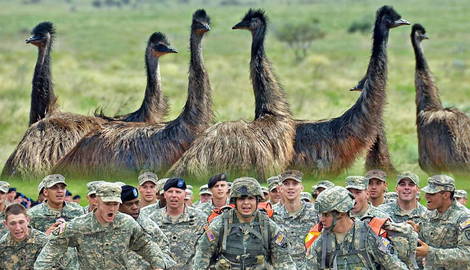
Emus can be destructive to farmland and crops like wheat. In the 1930s, Western Australia was becoming blighted by emu problems. Many farmers who had land were already struggling with inexperience as many were not previously full-time farmers but World War I veterans and many even gave up leaving to eke out a living in a different way. Australia decided to essentially create a military operation to tackle the problem of the emus. The campaign that ensued, now known as the Emu War, began in November 1932.
Emus and the Environment

Emus are the tallest bird that is native to Australia, and third overall in the world compared to two different species of ostriches in Africa standing at about 1.9 meters or 6 foot 3 inches. Females tend to be slightly bigger than males. There are three known subspecies natives to Australia, with a fourth type, now extinct, that lived on Tasmania, although they do have a pretty wide range through the country. They have brown feathers and wings that flap when they run. They are considered one of the symbols of Australia and even are featured on the Australian Coat of Arms along with a kangaroo. Up until the early 1920s they were a protected species before being considered a widespread nuisance.

Outside of the dingo, adult emus do not have natural enemies in the wild. Babies and eggs are a little more vulnerable. They can defend themselves against a dingo by attacking them and jumping and kicking the dingo, although it is not always successful. Emus were also used as a source of food by indigenous Australians and European settlers, and their fat was used as oil for lamps by the Europeans. Today they are still farmed as a source of meat like beef.
As animals go, they have very little aggression towards humans unless backed in a corner. So how did these birds take part in one of the most bizarre wars of all time, with the Australian government?
The Emu War Begins

As plans for the Emu War took hold in 1932, the Royal Australian Artillery sent out three members, with orders to kill 20,000 emus, using, of all things, machine guns. However, it is important to note that they didn’t want to eradicate the population, just thin the herd a little.
It might seem that sending military force with machine guns to cull a herd of emus is a bit of an overreaction, and that it would be a quick assignment. Except it was entirely unsuccessful.
Reports came in as emus were killed. One month went by, then two. The army’s eradication of emus only reached 1,000, making this a huge failure; they were widely ridiculed for being unable to deal with what was essentially a bunch of birds.
How Did Australians Lose the Emu War?

So, let’s examine how the Emu War was lost. First off, the physical aspect of the bird played a key role. Emus are a very hardy bird. It can take shooting them several times before they even react to being hit. They also are flight birds who will scatter when they sense danger, making it harder to hit them. Reports say that within the first week, although over 2,000 rounds of ammunition were shot, very few birds were actually hit and killed, with numbers ranging from 50-500 in that time. Ornithologist Dominic Serventy stated.
“The machine-gunners’ dreams of point-blank fire into serried masses of Emus were soon dissipated. The Emu command had evidently ordered guerrilla tactics, and its unwieldy army soon split up into innumerable small units that made use of the military equipment uneconomic.”
While obviously a joke, the fact that these shots were taken against birds who were not fighting back or performing actual military tactics and avoided death is impressive. Unfortunately, the media downplayed the number of emus killed in the first campaign, which made them a laughing stock.
The Aftermath

In the aftermath of the failed Emu War, farmers were allowed to take over the task of thinning out emus. There was a bounty placed on individual emus which resulted in 57,000 claims in only six months, almost triple the original plan. Large scale fences were also put up with some arguments on whether this could interfere with migration and affect the emu population, thereby making them a threatened or endangered species. Conservationists criticized the killing of the emus.
Ultimately, the Environment Protection and Biodiversity Conservation Act 1999 (EPBC Act) made Australian wild emus a protected species. The EPBC Act is the environmental law in Australia. It protects not just emus, but a wide range of plants, animals and habitats and has had various amendments throughout the years. As of 2023 there are an estimated 600,000-700,000 emus in the wild and they are considered a stable population. Meanwhile, the Emu War is considered one of the strangest battles that the Australian government fought, and lost.










